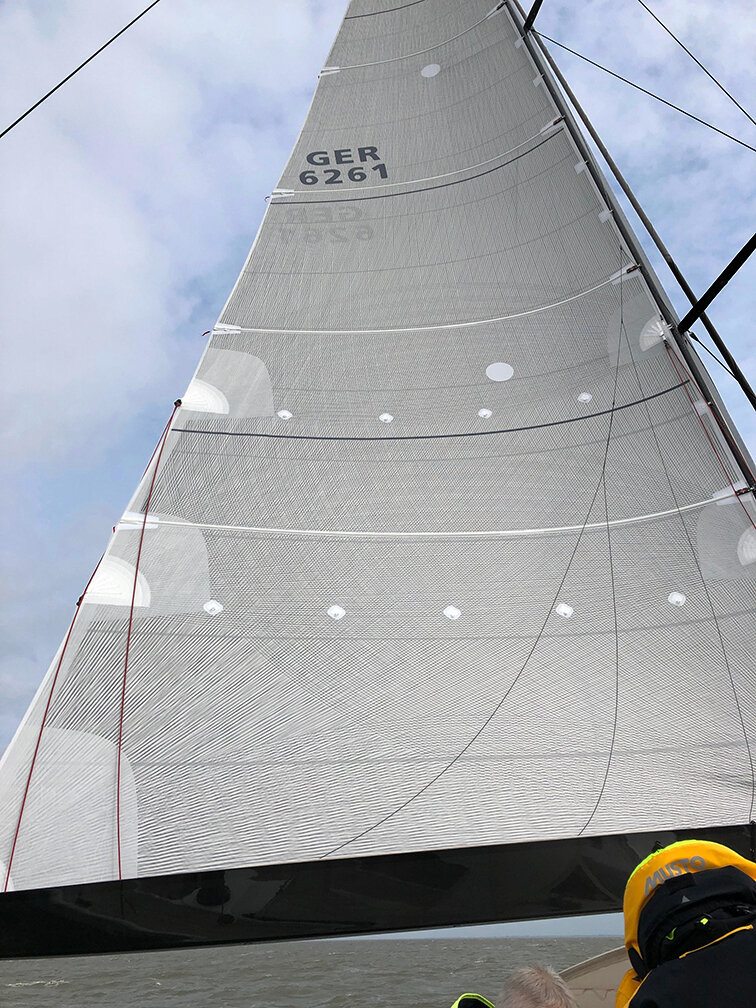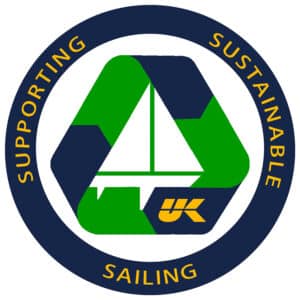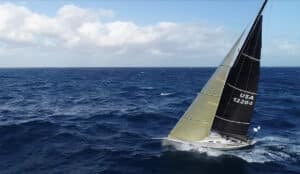A massive full-batten X-Drive main on a Swan 60. Every other reinforcing fiber is carbon next to an Endumax fiber. The mix of carbon and Endumax (a relative of Spectra and Dyneema) gives the be benefits of both fibers — zero stretch and durability.
By Oliver McCann
Full-length battens have many virtues for cruising sailors, including better shape-holding, more longevity, and easier sail handling. The sails last longer because the full-length battens prevent flogging (the violent snapping back and forth that occurs when tacking, reefing, hoisting or lowering the mainsail).
As conventional sails flog, the sailcloth breaks down, especially at the front end of the battens where the leech of the sail “hinges” back and forth. Flogging is the prime culprit in sail wear-and-tear, ergo, full-length battens are an attractive option. However, as full batten mainsails help from a performance and durability perspective, their added stiffness and rigidity can make them more difficult to raise and lower compared to a traditional short batten sail.
UK Sailmakers provides two specific solutions for this and other sail handling challenges, allowing short-handed sailors to manage their mainsails with relative ease.
First, we overcome much of the luff slide friction that full battens generate by adding a Tides Marine Strong Track system. The Strong Track is a one-piece, low-friction track that slides up into the groove or track in the back of your mast. When installed, the mainsail will hoist easily and drop the instant the halyard is released because the track is extrude out of a super-slick UHMWPE plastic. Here’s a video on Tide Marine tracks:
The Tides Marine Strong Track is custom milled to slide into the groove or track on the back of your mast.
Second, we provide our well-engineered Lazy Cradle to contain the sail as it’s lowered and dropped. The Lazy Cradle, when attached to your boom, creates a well into which the sail will fall when lowered. When combined with lazy jacks, this Lazy Cradle zippered sail cover neatly flaks and stows the mainsail with little effort. Here is a link to our photo album of some of the Lazy Cradles we have delivered to customers with a variety of boats.
Third, is the addition of an electric winch to aid in raising the mainsail. While an expensive solution, a powered winch can make all the difference when raising a heavy main. UK Sailmakers can recommend riggers who install or retrofit electric winches. An electric winch handle option is a more affordable alternative to an electric winch.
There are other solutions to managing mainsails, including in-boom furlers, and in-mast furlers, both of which are far more expensive than the Tides Track and Lazy Cradle combination. We can offer guidance for these systems as well.
Don’t hesitate to ask us how we can help you better manage not just your mainsail, but all your sails with less effort. We at UK Sailmakers are dedicated to providing our customers with the best sailing experience.
And, if you’d like to learn more about the benefits of full-length batten mainsails, click on this link: https://www.uksailmakers.com/cruising-main-construction-options/full-batten-main





Oliver,
I love the tides track in combination with the batten luff swivel lugs that drop the mainsail of my Catalina 42 Mk II in exactly 1 second into the UK lazy cradle…I have timed that!
More importantly, everyone shouting upon sail drop "head up, head up into the wind" I over shout "no, do not head up any further" release halyard now; and that easily when 15 degrees or more off the wind, just let out the sheet a bit more. Everyone is totally surprised and amazed because, while they are still shouting "head-up", the sail is already secured "in the lazy cradle. Approaching age 80 with first made into her 80-ties, I do not want to fight with a sail, having to go forward to pull the luff down, flake,tie down, etc. the usual stuff. I must admit the weight of the battens and heavy swivels, in addition to the weight of a tall sail makes it work for me to pull up the sail all alone, although I take my time hand cranking the winch. I have considered to install the add-on electric actuator for the Lewmar winch, but I am afraid when something would hang up I rip the sail….have done that with a previous older sail at night using the winch while a reef line, not visible behind the sail, was hanging up due to an abnormality and the luff cringle with some sail tore out. Alhough that will not happen again, now know what to look for, there is always some new unexpected experience….tatis sauiling.
Oliver,
I love the tides track in combination with the batten luff swivel lugs that drop the mainsail of my Catalina 42 Mk II in exactly 1 second into the UK lazy cradle…I have timed that!
More importantly, everyone shouting upon sail drop "head up, head up into the wind" I over shout "no, do not head up any further" release halyard now; and that easily when 15 degrees or more off the wind, just let out the sheet a bit more. Everyone is totally surprised and amazed because, while they are still shouting "head-up", the sail is already secured "in the lazy cradle. Approaching age 80 with first made into her 80-ties, I do not want to fight with a sail, having to go forward to pull the luff down, flake,tie down, etc. the usual stuff. I must admit the weight of the battens and heavy swivels, in addition to the weight of a tall sail makes it work for me to pull up the sail all alone, although I take my time hand cranking the winch. I have considered to install the add-on electric actuator for the Lewmar winch, but I am afraid when something would hang up I rip the sail….have done that with a previous older sail at night using the winch while a reef line, not visible behind the sail, was hanging up due to an abnormality and the luff cringle with some sail tore out. Alhough that will not happen again, now know what to look for, there is always some new unexpected experience….tatis sauiling.